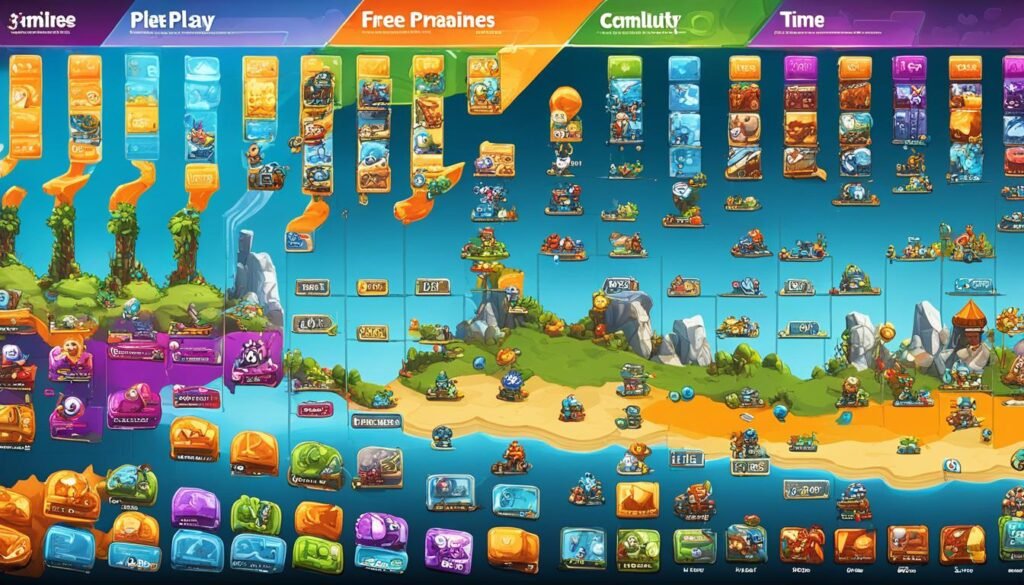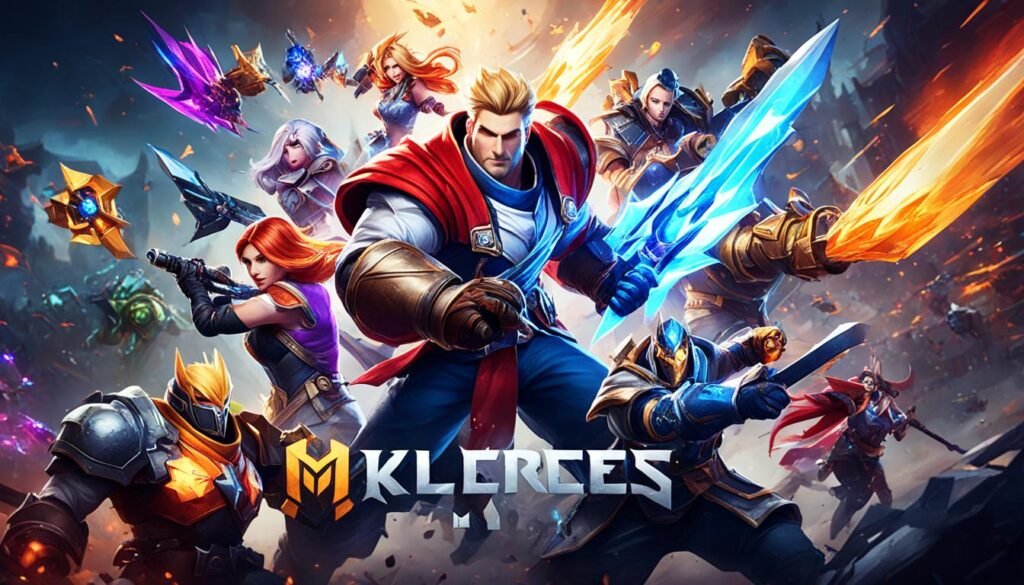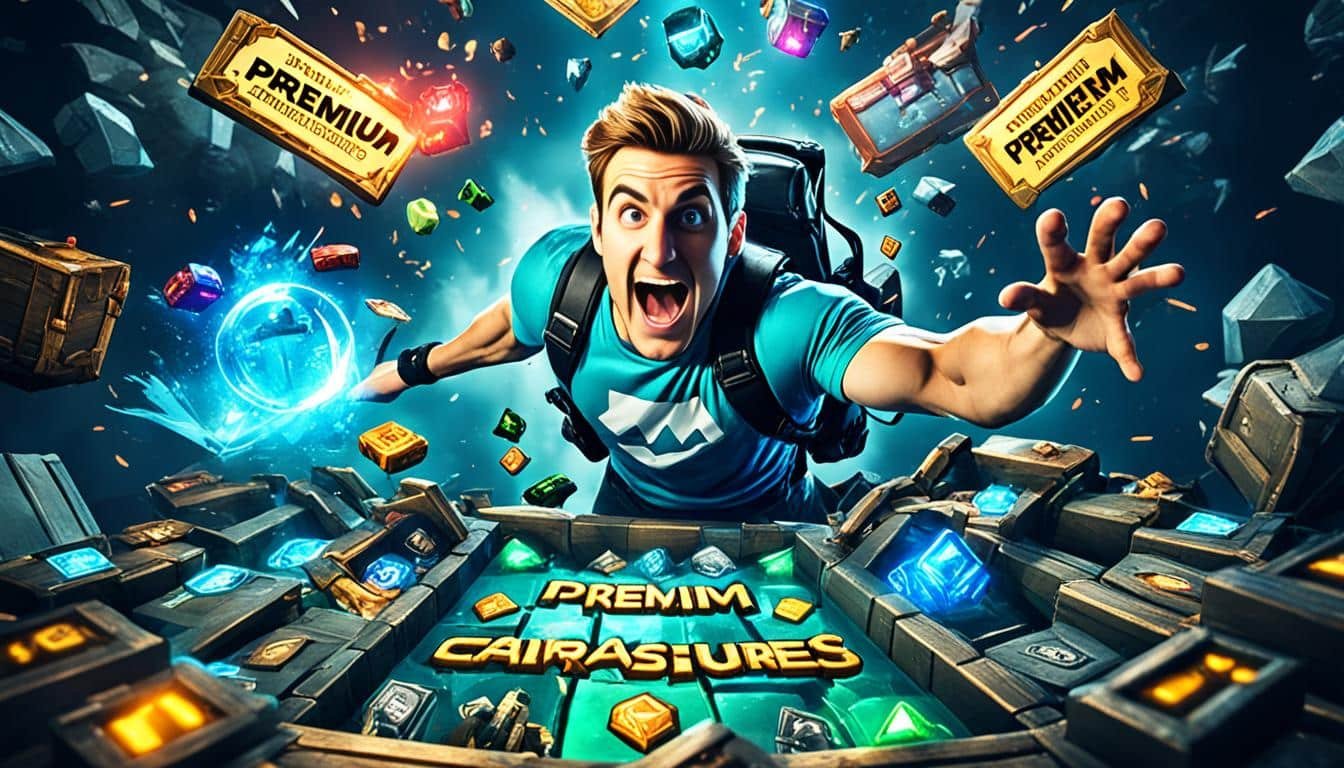In the world of video games, many games follow the free-to-play (F2P) model. This lets players enjoy a lot of the game without paying first. But, to get the best out of the game, players can buy in-game items. These items can give players special content, an edge in competition, or speed up their progress.
This model is popular with game makers because it draws in more players and makes money through optional buys. By letting players try the game for free, developers can reach more people. Then, they encourage players to buy more to make the game profitable.
Key Takeaways : Features In Free Games
- Free-to-play games let players try a lot of the game without paying upfront.
- Players can buy premium features or virtual goods to make their game better, like special items or an edge in competition.
- The free-to-play model is a hit with developers and publishers for drawing in more players and making money through game buys.
- Premium features can be many things, from just looking better to changing how the game plays.
- It’s important to balance free and premium content so the game is fair and fun for everyone.
Also Read : Exploring The World Of Pogo Games
Free-to-Play Business Model
In the world of gaming, the free-to-play model is very popular. It lets players start playing without paying upfront. This model, called the freemium software model, lets users play the main game for free. But, they can buy more content or features if they want.
Microtransactions and Virtual Goods
Microtransactions are a big part of the free-to-play model. Players can buy virtual items or upgrades for a little money. These items, like cosmetic changes or things that help in the game, make money for the game makers.
In-Game Advertisements
Free-to-play games also use in-game advertisements. These ads are placed in the game and make money for the developers. Players can choose to watch these ads to get rewards or benefits in the game.
Cosmetic Upgrades and Pay-to-Win Concerns
Some free-to-play games have been criticized for being unfair. They offer cosmetic upgrades or items that give players who pay a big advantage. This can make it hard for players who don’t pay to keep up.
Game developers face a big challenge. They need to make the game fair and fun for everyone. At the same time, they need to make money from optional purchases.
Also Read : The Best Racing Games For Speed Lovers
History of Free-to-Play Games

The free-to-play game model started in the late 1990s and early 2000s. It came from the success of massively multiplayer online games (MMOs) aimed at casual and young gamers. Games like Furcadia, Neopets, and RuneScape led the way, giving players free access to their worlds.
As the video game industry grew, many MMOs with subscription fees changed to free-to-play in the late 2000s. Games such as The Lord of the Rings Online and Dungeons & Dragons Online moved to this model. They found it increased player interest and brought in more money through in-game buys.
Early Massively Multiplayer Online Games
The free-to-play model became popular with the rise of MMOs in the late 1990s and early 2000s. Games like Furcadia, Neopets, and RuneScape let players explore their worlds for free. They could also buy extra content or features with microtransactions.
Transition from Subscription-Based Models
Many MMOs with subscription fees switched to free-to-play in the late 2000s. The Lord of the Rings Online and Dungeons & Dragons Online made this change. They saw more player interest and made more money through in-game purchases and microtransactions.
| Game | Initial Model | Transition to Free-to-Play | Impact on Player Engagement |
|---|---|---|---|
| The Lord of the Rings Online | Subscription-based | Free-to-play | Increased player engagement and revenue |
| Dungeons & Dragons Online | Subscription-based | Free-to-play | Increased player engagement and revenue |
Game Mechanics

Free-to-play games use certain tactics to get players to buy in-game items. These include time-limited items, dual currencies, and energy bars. They aim to keep players interested and make money.
Time-Limited Items
Time-limited items are a key tactic. They are virtual goods or features that vanish after a while. This makes players want to buy them before they’re gone.
Dual In-Game Currencies
Many free-to-play games have two currencies. One you earn by playing, and the other you buy with real money. This setup makes it hard for players to move forward without buying the premium currency.
Energy Bar Mechanics
Energy bars limit how much you can do in a set time. When the bar is empty, you must wait or buy more to play. This pushes players to spend money to keep playing.
These mechanics are made to keep players hooked and make money. They help support the free-to-play model that’s popular in gaming.
Also Read :Top 10 Typing Games To Improve Your Keyboard Skills
Features In Free Games

Free-to-play games let players try out a lot of their content without paying first. This means players can dive into the game without spending money upfront. But, these games also let players buy extra things to make their experience better. This way, developers hope players will want to spend money to get more from the game.
Some of the main things players can buy in free games include:
- Exclusive content – Like special levels, characters, or scenarios only for those who buy things.
- Power-ups and boosters – Items that give a temporary edge or speed up progress in the game.
- Customization options – Ways to make the player’s avatar, gear, or other game items unique.
These special features aim to make the game more fun and interesting. They add more depth, challenge, or ways to personalize the game. By mixing free and paid content well, developers aim to make a game that draws players in and makes them want to spend money.
“The free-to-play model allows players to try out a game without any financial risk, while still providing opportunities for those who wish to enhance their experience.”
Adding premium features to free games is a tricky task. Developers aim to keep the game fair and fun for everyone. By understanding how to balance free and paid content, game makers can make games that attract many players and make money from optional buys.
Also Read :Why Vintage Consoles Still Matter in Modern Gaming?
Transition to Free-to-Play by Major Publishers

In recent years, the video game industry has seen a big change towards the free-to-play model. Many big publishers have made the switch, turning some of their well-known games or launching new ones for free. The outcomes have varied, with some doing well and others not so much.
Successful Transitions
Some big names in gaming have hit it off with the free-to-play model. For instance, The Lord of the Rings Online and Star Wars: The Old Republic drew more players and made more money after going free-to-play. They kept their core gameplay and stories but added in microtransactions and ads to make more money.
Unsuccessful Attempts
But not every move to free-to-play worked out. Games like Age of Empires Online and Command & Conquer: Generals 2 didn’t catch on and were closed down. They couldn’t match the success of their earlier versions under the new model. These failures show the hurdles publishers face in making old games work in the free-to-play world.
Switching to free-to-play has been hit or miss for big publishers. It’s tricky to use the free-to-play model’s strengths while keeping the charm of well-known games. This balance is hard for many in the video game industry to get right.
Also Read :The Best Vintage Games From The Golden Age Of Gaming
Revenue Generation and Player Segments

Free-to-play games often make money from a few players, called “whales,” who spend a lot on in-game items. These whales and another group, “dolphins,” who spend a bit more, make most of the money. The rest, known as “minnows,” don’t spend much.
Game developers work to make sure all players feel welcome. They design their games to keep whales and dolphins coming back. At the same time, they make sure minnows enjoy the game too, hoping they might start spending more.
| Player Segment | Spending Behavior | Contribution to Revenue |
|---|---|---|
| Whales | Significant in-game spending | Majority of revenue |
| Dolphins | Moderate in-game spending | Significant portion of revenue |
| Minnows | Little to no in-game spending | Majority of players, but contribute little to revenue |
By focusing on different player types, game developers can make more money and keep players happy. This way, everyone, from big spenders to those who don’t spend much, has a good time.
Comparison with Traditional Premium Model
The free-to-play model is a big change from the old way where players paid a lot upfront. Now, the goal is to keep a lot of players and offer ways for them to spend money. This approach focuses more on keeping players interested than just selling games.
Player Engagement Metrics
For free-to-play games, how well players stick with the game is key. This is different from the old days when success was all about how many copies were sold. Keeping players hooked is important for making money from in-game buys and ads.
Spending Patterns
Players don’t spend as much all at once in free-to-play games. Instead, they buy small things over time, like extra content or cool items. This means games can make money in different ways, with a few very active players bringing in a lot of cash.
Switching to free-to-play has changed the game industry a lot. Now, making games means focusing on keeping players interested and getting them to spend money. Knowing these changes is key for success in the gaming world.
Popularity of Free-to-Play MOBAs

Free-to-play Multiplayer Online Battle Arena (MOBA) games have changed the video game world. Games like League of Legends, Dota 2, Heroes of the Storm, and Smite have become huge hits, drawing in millions of players from all over.
These games have led the way with a new way of making money. Many game makers now follow this model. It has changed how games are made and sold.
MOBAs show how well this way of making money works. Players can start playing for free. Then, they can buy extra items or cool looks for their characters. This method brings in a lot of money for game creators. It also keeps the games exciting and easy to get into.
| Game | Release Year | Estimated Players | Revenue Model |
|---|---|---|---|
| League of Legends | 2009 | 180 million | Free-to-play with microtransactions |
| Dota 2 | 2013 | 105 million | Free-to-play with microtransactions |
| Heroes of the Storm | 2015 | 15 million | Free-to-play with microtransactions |
| Smite | 2014 | 25 million | Free-to-play with microtransactions |
The success of these MOBA games has made the free-to-play model popular in the gaming world. It has changed how both small and big game makers plan their strategies.
“The free-to-play MOBA genre has demonstrated the power of this monetization strategy, where players can access the core game for free while having the option to purchase optional in-game items or cosmetic upgrades.”
Mobile Free-to-Play Games

Mobile gaming has seen a big win with the free-to-play model. Games that are free to play make more money than paid ones on places like the Apple App Store. Even though just about 1.5% of players buy in-game items, these “whales” can bring in a lot, up to 50% of the game’s earnings. This lets developers of hits like Clash of Clans and Game of War spend a lot on marketing and getting new players.
Player Spending on Mobile Games
Mobile free-to-play games have changed the gaming world. Developers use in-app purchases and small transactions to make a lot of money from just a few players. This way, they can offer their games for free, drawing in more players and boosting spending on mobile games.
| Metric | Value |
|---|---|
| Percentage of players who make in-app purchases | ~1.5% |
| Percentage of revenue from “whales” | Up to 50% |
| Revenue from mobile free-to-play games | Surpassing premium games |
The success of mobile free-to-play games has changed the game for developers. It lets them reach more people and make a lot of money with new ways to make money. As mobile gaming grows, this model will keep shaping the gaming world.
“The free-to-play model has transformed the mobile gaming industry, enabling developers to reach a wider audience and generate substantial revenue through in-app purchases and microtransactions.”
Conclusion
The free-to-play model has changed the video game world. It lets developers reach many players and make money through in-game buys. Critics say it can lead to unfair play, but it also lets players get extra features without paying upfront.
This model is still growing and will likely stay big in the game world. It’s all about making money, keeping players interested, and understanding how they spend. This makes the game industry dynamic and flexible for today’s gamers.
The key to the free-to-play model’s success is finding a good balance. It must offer a great game experience and make enough money for developers. As new ideas come up, the free-to-play model will keep shaping the future of games.
FAQs
Q: How can I access premium features in free-to-play games?
A: In most free-to-play games, you can access premium features by making in-game purchases using real money. These purchases can unlock new content, items, or abilities that are not available to regular players.
Q: What are some common examples of free-to-play games in 2024?
A: Some common examples of free-to-play games in 2024 include popular titles like Fortnite, Apex Legends, and League of Legends.
Q: Are free-to-play games designed differently from traditional games?
A: Yes, free-to-play games are designed to be accessible to a wide audience without the need for upfront payment. They often rely on microtransactions or advertising revenue to generate profits.
Q: How can I try out a new game without paying?
A: You can try out a new game for free by downloading it from online stores like Steam or the Epic Games Store. Many games also offer free trial periods or demos for players to test out before making a purchase.
Q: What is the role of accessibility in free-to-play games?
A: Accessibility in free-to-play games refers to the ease with which players can access and enjoy the game without facing barriers related to technology, hardware, or payment. Developers strive to make their games user-friendly for a diverse player base.
Q: How does spending money in free-to-play games affect gameplay?
A: Spending money in free-to-play games can unlock additional content or advantages that may enhance your gameplay experience. However, it is not necessary to spend money to enjoy and progress in most free-to-play titles.
Q: Can I access premium features in browser-based free games?
A: Yes, browser-based free games also offer premium features that can be accessed through in-game purchases. These games may require you to link your account or use a payment gateway to unlock premium content.
Source Links
- https://en.wikipedia.org/wiki/Free-to-play
- https://www.playstation.com/en-us/ps-plus/
- https://www.playstation.com/en-us/ps-plus/getting-started/





